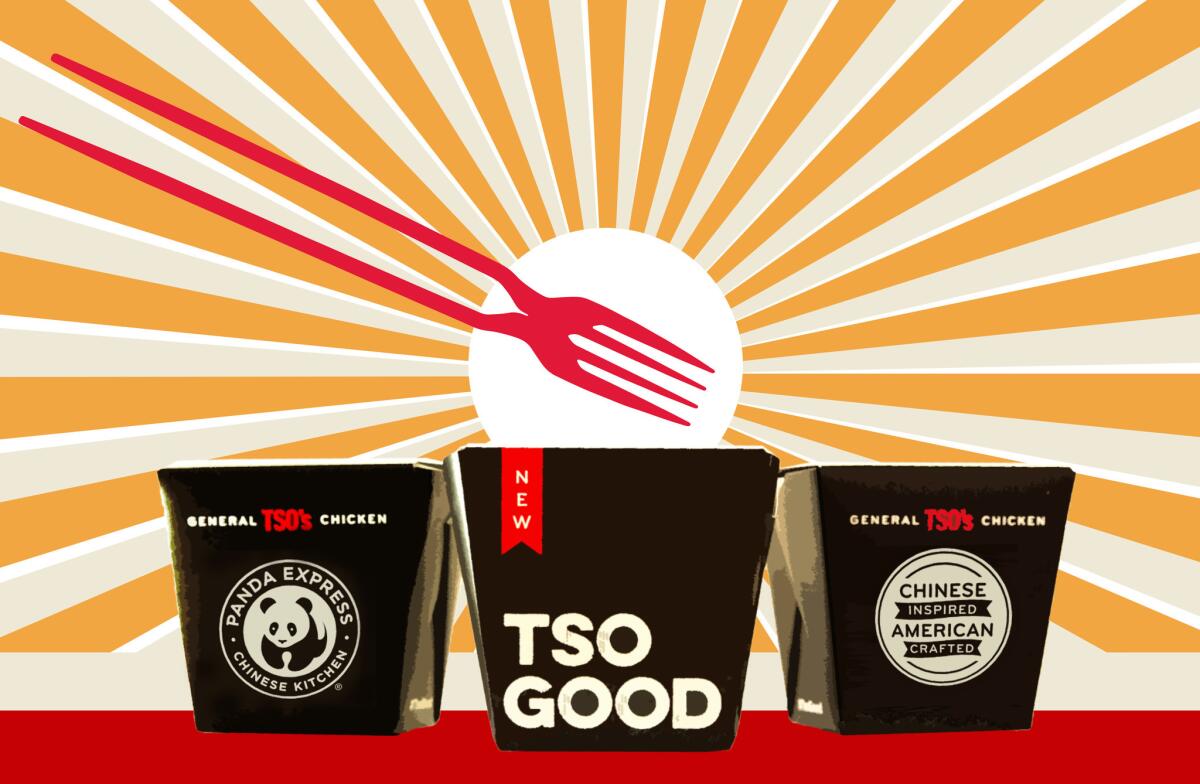Why Panda Express and the chork go hand in hand: Both are more American than Chinese

Last week, Panda Express unveiled its first-ever take on the Chinese American classic General Tso’s chicken, using the hashtag #TsoGood to gin up excitement on social media.
The Internet, however, was more interested in the company’s nifty new utensil, the chork.
It all started when Lisa Jennings, a reporter for Nation’s Restaurant News who was attending the General Tso’s chicken launch at the Glendale Galleria on Aug. 10, tweeted a picture of a red plastic tool that looked like a fork on one end and a chopstick on the other.
It didn’t take long for the utensil to go viral, eliciting hundreds of press reports and tweets from luminaries like venture capitalist Marc Andreessen.
“Genius,” he wrote. “Surprising it only took 3,200 years to invent!”
At Panda Express’ headquarters in Rosemead, the news was greeted with dumbfounded delight. Executives were inundated with press inquires and calls from the public to roll out the chork to all 1,900 of its stores.
“It hit a cultural zeitgeist that surprised us,” Andrea Cherng, Panda Restaurant Group’s chief marketing officer, said Thursday in the company’s first interview since the phenomenon took off.
The utensil, Cherng said, is a perfect symbol of Panda Express’ American Chinese identity.
Much like General Tso’s chicken, the chork is “accessible, but still rooted in something authentically Chinese,” she said. “It’s a mash-up that embodies our two cultures.”
The chork does not belong to Panda Express. It’s the invention of a Salt Lake City company that debuted the utensil at the 2010 National Restaurant Assn. show in Chicago.
It was developed out of necessity, said one of its inventors, Jordan Brown.
“I always felt I was decent at using chopsticks, but I always have to revert to a fork near the end of the meal to get the last pieces of rice or pick up something slippery,” said Brown, vice president of product development at Brown Innovation Group, the chork’s lone manufacturer.
While the chork can be used from both ends, it can also be snapped in two to create a more traditional pair of chopsticks. Brown said much of the company’s R&D work centered on getting the plastic just the right strength for the snap.
What makes the chork so special, Brown said, is how useful it is as a marketing tool.
“People love to take them home,” he said.
Brown’s company sells the chork online in packs of 24 ($9.99) and 12 ($7.99). The utensils are manufactured in China.
Panda Express first discovered the chork at the National Restaurant Assn. show, though it’s unclear which year. Since then, the utensil has appeared at company catering events. An employee is also considering using it at her upcoming wedding.
The company is crunching numbers to see if it can offer the chork to customers nationwide for the first time alongside its normal plastic forks, spoons and knives and wooden chopsticks.
For now, Panda Express has only promised to give out the chork at special events, including one this Saturday in Chinatown where the company has organized a panel on American Chinese food.
The chain will also give away the utensil at most stores on Nov. 10 to celebrate General Tso’s birthday (yes, he actually existed; and no, he did not invent the dish).
Unlike Panda Express’ popular orange chicken, General Tso’s chicken is made with white meat and includes vegetables. It’s also not as sweet.
Cherng said the menu item was developed over two years and required research tours of mom-and-pop Chinese takeout restaurants on the East Coast, where the dish is more established.
“We’re bringing two pillars of American Chinese cuisine to a wider audience,” Cherng said.
Panda Express was founded in 1983 by Cherng’s immigrant parents, Andrew and Peggy Cherng. The chain’s first location still exists in the Glendale Galleria. The wholly owned private company is adding, on average, 100 new stores a year and registered $2.4 billion in revenue in 2015.
Follow me @dhpierson on Twitter







